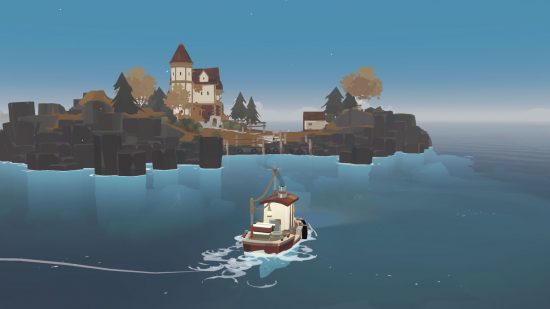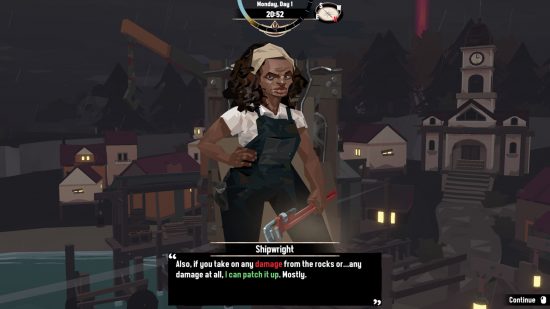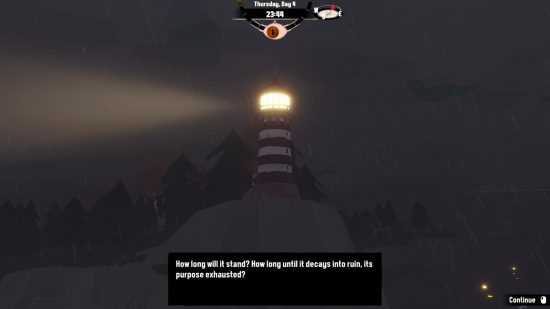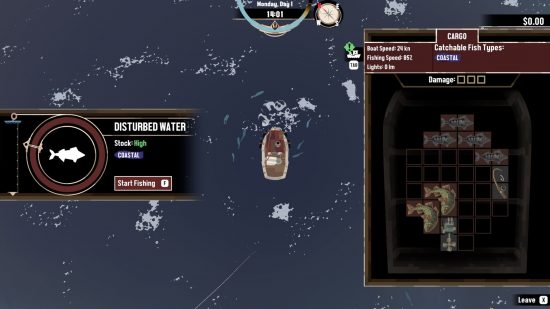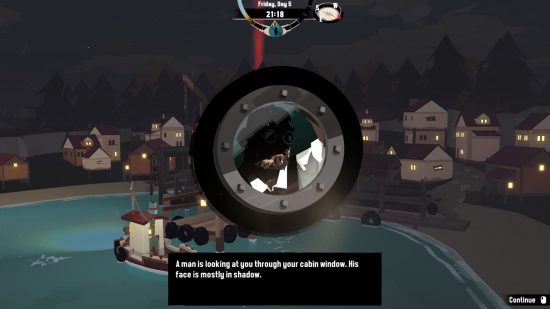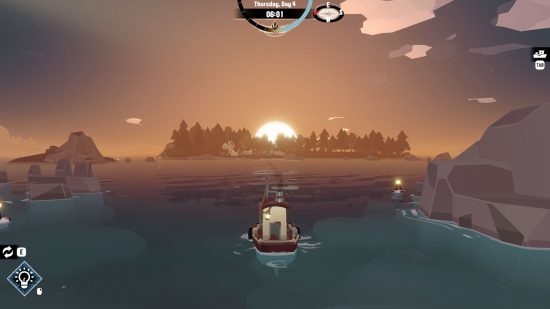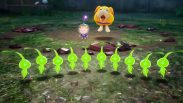Dredge is a very striking experience and one that I won’t soon forget. I went into it relatively blind, and am happy to find myself pleasantly surprised by its deliciously dark depths. While I’ve long been a fan of Team 17’s games, the countless hours I’ve spent throwing onions around in Overcooked could never prepare me for what this pearl of the ocean has to offer.
Of course, first impressions are often made on visuals alone – and I was immediately taken aback by just how beautiful yet simplistic the game looks. Dredge’s world design is blocky, angular, and highly stylised, with muted colours and chunky textures reminiscent of the modernist art style that many of my favourite indie games follow.
However, the character design is something different altogether. Each of the odd individuals you meet fit perfectly with their simple backdrop, while also standing out through their striking, emotive faces. They each consist of broad, geometric brush strokes, reminiscent of traditional oil paintings done with a palette knife, and their caricature-like proportions immediately clue you into their personalities before you’ve even had the chance to chat with them.
The character illustrations are static, and the rare cutscenes are predominantly made up of static, overlapping assets that move on separate planes like a pop-up picture book. While this may not appeal to everyone, I feel it makes for a great contrast between the fluidity of the ocean and the stationary nature of the land and gives the game an overall feel akin to a haunting bedtime story.
Dredge’s setting is initially very simple. You’re a fisherman in search of work. You see an ad for an angler job and set out upon the sea. However, the ocean is a treacherous place and you soon find yourself wrecked upon the shore of a small town called Greater Marrow. The Mayor informs you that he has fixed your boat up and brought you to shore, but you now need to repay the reparation fees by – huh, taking up an angler job and selling the fish you catch? Life’s funny sometimes, isn’t it?
The tutorial sees you take to the shallows in your rickety little boat, with simple directions showing you how to move, control your camera, and cast out your line. It’s simple and digestible and allows you to explore other features with relative freedom right off the bat. However, it was when the tutorial started explaining the time system that I started to realise not all might be as it seems.
At the top of your screen, your UI shows you the date, time, and a compass – all the stuff you’d expect when setting out on a standard seafaring job. But then the game informs you of the paranoia system, displayed by the unnerving eye (or, to be precise, your unnerving eye) which darts around erratically as the darkness creeps in. The game informs you that the longer you stay out at night, the more paranoid you get, and only spending time within reach of bright lights or bringing your ship to a dock can shake off those heebie-jeebies. But what exactly are you paranoid about?
The gameplay cycle primarily revolves around you setting out to sea to catch fish and, later, dredge up materials and other items. There are multiple islands with docks where you can rest, sell or store your cargo, or fix and upgrade your boat. Time passes whenever you’re moving on the water, fishing, or installing an upgrade, so you need to be organised with your time management to avoid spending too much time out on the sea at night.
Your ship’s cabin consists of a grid inventory, with a Tetris-like puzzle system. You must find the most economical layout to store your upgrades and tools (such as motors, fog lights, fishing rods, and crab cages), as well as all the fish and other cargo you pick up on your expeditions. If you hit an obstacle while out at sea, it’s highly likely that you’ll damage your hull, which renders one or more of your grid slots unusable. If you’re unlucky enough to damage a slot that’s holding an item, you lose that item overboard. Luckily, there are plenty of upgrades for you to purchase as you progress, allowing you to increase your ship’s capacity, speed, and more.
Fishing consists of you approaching a spot of disturbed water and casting your line, then completing a short QTE-style minigame where you need to hit the ‘reel’ button when the marker is in the correct place. Dredging is similar but instead consists of overlapping wheels that constantly spin, requiring you to flick your marker between the wheels to avoid gaps. If you struggle with these types of games, you’ll be glad to know that the accessibility menu has the option to toggle ‘relaxed fishing mode’, which makes the system much easier.
Beyond the old sailing and fishing, Dredge has a non-linear narrative for you to explore through an array of side missions called ‘pursuits’. These give you some direction and goal to aim towards after you’ve repaid your debts, and often reward you with money, items, and lore exposition. Some are very simple, requiring you to gather a couple of specific fish for an order at the fishmongers, whereas others are more unique, such as a castaway asking if you can transport him to a dock, or a collector asking you to dredge up different relics and items.
This is the next part where you start to realise that Dredge is far more than a quaint fisherman simulator. As you go about dredging up a variety of items and reporting back to the landlubbers, you start to see the threads of a much darker world unravel. Mysterious disappearances, deformed fish, strange sounds, and haunting visions that plague the night – the sea may be your home in this game, but it’s still a vast and unpredictable expanse, with plenty of secrets hidden in the depths.
I shan’t go any further into the mysterious narrative you unveil as you continue to cast your net further and further out, as I feel it’s much better to experience it blind as I did. However, I will say that the twists and turns to the story, as well as the almost Lovecraftian vibe to the creatures of the deep, are all delightfully dark and otherworldly, and the warning of setting out on the sea at night should not be taken lightly.
In fact, as the curious catfish I am, I decided to test the waters a little too much, and found myself plagued by a swirling mass of unsettling hallucinations – but were they really hallucinations? Either way, as the title of this preview suggests, what at first appeared to be a ship off in the distance soon revealed itself to be an abhorrent anglerfish-like monster, and a poor builder I was transporting found herself paying the price. Sorry friend, you’re sleeping with the (monstrous) fishes now.
In terms of performance, I’m playing this beta on Steam and it runs like a dream. No stuttering, no framerate drops, no glitches – everything is as smooth as butter, and I hope that the Switch version maintains this. The controls are also comfortable and easy to grasp, with intuitive layouts, non-intrusive prompts, a well-sized and attractive UI, and responsive inputs that make the minigames a breeze. Controlling the boat can be a little exhausting at first, as you move quite slowly and turn even slower, but this is entirely befitting of the style of the game and makes the later upgrades all the more gratifying.
The final point I want to touch on in this preview is the wonderful sound design. Dredge is not voiced beyond a few grunts from the NPCs, but, to me, that only amplifies the isolation and loneliness of the protagonists’ life. The music is moving and mournful, combined with the lapping of the waves to set the scene perfectly.
Overall, I’ve had a wonderful experience with Dredge so far. It’s a truly striking game that dredges up (ha, get it?) a real sense of emotion, and its simple yet enjoyable gameplay loop acts as the perfect ship to carry the cargo of its dark and mysterious narrative. I highly recommend hopping aboard and slipping into the ocean’s cold embrace – just be sure to keep those fog lights on to keep the heebie-jeebies at bay tonight.
